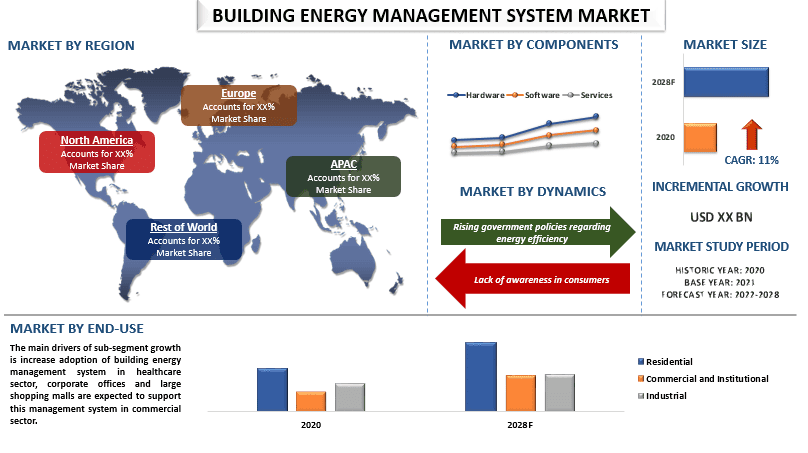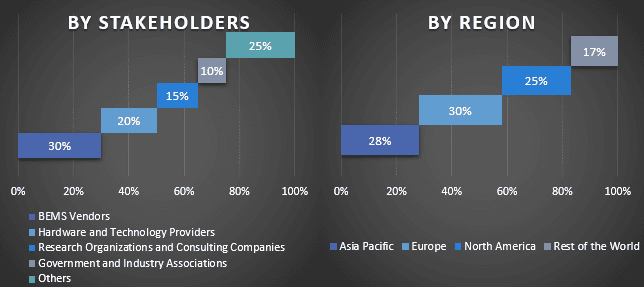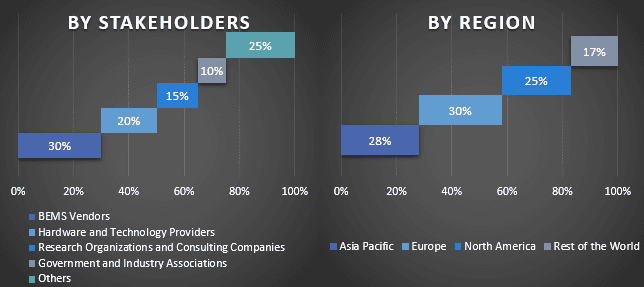Emphasis on End-User (Residential, Commercial & Institutional, and Industrial), Component (Hardware, Software, and Services); Connectivity Type (Wired and Wireless), and Country/Region.

A building energy management system is a computer-based system that monitors and regulates the electrical and mechanical equipment in a structure. It can control lighting, power systems, heating, and ventilation while also conserving energy and lowering carbon emissions. A central supervisory computer is connected to a number of hubs distributed around the facility through cables.
Global Building energy management system market is expected to register a robust CAGR of around 11% over the period of 2022-2028. The growth of the market is influenced by factors such as emerging demand for reduced energy costs to traditional systems and better power savings. The market has evolved dramatically in the last few years, with many adaptable technologies rendered in the market. Moreover, the increasing use of building energy management system in hospitality service and corporate offices open up new opportunities for the building energy management system market. For example, in recent years, a growing emphasis on optimizing electricity, heating, ventilation, and air conditioning of buildings to increase energy efficiency has boosted the implementation of building energy management systems.
Moreover, development in advanced sensors and controls are also expected to fuel growth of the global building energy management system market during the forecast period. Advanced sensors and controls are used to improve energy systems in commercial buildings. Rising focus on optimizing electricity and heating, ventilation, and air conditioning (HVAC) of buildings to improve energy efficiency has been boosting deployment of building energy management systems in the recent past ABB Ltd., CISCO Systems Inc., Emerson Electric Co., Rockwell Automation Inc., General Electric, Siemens AG, Honeywell International Inc., IBM Corporation, Ingersoll Rand Plc, and Johnson Controls Inc. are some of the key players in the market. Several M&As along with partnerships have been undertaken by these players to facilitate customers with hi-tech and innovative products/technologies.
Insights Presented in the Report
“Amongst components, software category is the most demanding Building energy management system for upcoming years”
Based on components, the market is divided into hardware, software, and services. The software segment grabbed the major market share and dominated the market in 2020. The software segment includes asset performance optimization, data management, application platform, lighting system, and heating, ventilation, and air conditioning (HVAC). Increasing investment by major players in the market for the incorporation of data analytics software in their existing building energy management systems, is expected to further support revenue growth of the software platforms segment in the forthcoming years.
“Amongst Connectivity Type the wireless category is expected to witness highest CAGR during the forecast period”
Based on connectivity type, the market is categorized into wired and wireless communication. The wireless category is expected to witness higher CAGR during the forecast period. The factors attributed to the growth of this segment are rapid digitalization and the increased adoption of smart devices. Moreover, the additional cost of wiring, labor, and time for physically deploying wired building energy management systems are factors resulting in increased demand for wireless systems over wired systems.
“Amongst End-user, the commercial category is expected to witness the highest growth during the forecast period”
Based on end-user, the market is categorized into residential, commercial & institutional, and industrial. The commercial category is expected to witness a higher CAGR during the forecast period. The factors can be attributed to the increase in demand for infrastructural development in inter-country and the growing demand for building energy management systems in commercial sectors and efficient energy use. Furthermore, the increasing need for sustainable development and energy security are some key factors contributing to the rising demand for these systems in the commercial sector.
“APAC to witness significant growth during the forecast period”
Asia-Pacific is expected to show the highest CAGR growth in the building energy management system market. This is because of the increasing adoption of building energy management systems in developing countries like China, and India. Moreover, the government of India heavily investing in building energy management systems to reduce carbon norms and usage of electricity consumption. While other countries in the region such as Japan and South Korea are projected to improve their share through the up-gradation and deployment of new Building energy management system products.
Reasons to buy this report:
Customization Options:
Global Building energy management system market can further be customized as per the requirement or any other market segment. Besides this, UMI understands that you may have your own business needs, hence feel free to connect with us to get a report that completely suits your requirements.
1. Market Introduction
2. Research Methodology Or Assumption
3. Market Synopsis
4. Executive Summary
5. Global Building Energy Management System Market Covid-19 Impact
6. Global Building Energy Management System Market Revenue, 2020-2028f
7. Market Insights By Components
8. Market Insights By Connectivity Type
9. Market Insights By End-user
10. Market Insights By Region
11. Building Energy Management System Market Dynamics
12. Building Energy Management System Market Opportunities
13. Building Energy Management System Market Trends
14. Policy & Regulatory Framework
15. Demand And Supply-side Analysis
16. Value Chain Analysis
17. Competitive Scenario
18. Company Profiled
19. Disclaimer
Research Methodology for the Building Energy Management System Market Analysis (2022-2028)
Analyzing the historical market, estimation of the current market, and forecasting the future market of the building energy management system market were the three major steps undertaken to create and analyze the adoption of the building energy management system market in major regions globally. Exhaustive secondary research was conducted to collect the historical market numbers and estimate the current market size. Secondly, to validate these insights, numerous findings and assumptions were taken into consideration. Moreover, exhaustive primary interviews were also conducted, with industry experts across the value chain of the building energy management system market. Post assumption and validation of market numbers through primary interviews, we employed a top-down/bottom-up approach to forecasting the complete market size. Thereafter, market breakdown and data triangulation methods were adopted to estimate and analyze the market size of segments and sub-segments the industry pertains to. Detailed methodology is explained below:
Analysis of Historical Market Size
Step 1: In-Depth Study of Secondary Sources:
Detail secondary study was conducted to obtain the historical market size of the building energy management system market through company internal sources such as annual report & financial statements, performance presentations, press releases, etc., and external sources including journals, news & articles, government publications, competitor publications, sector reports, third-party database, and other credible publications.
Step 2: Market Segmentation:
After obtaining the historical market size of the building energy management system market, we conducted a detailed secondary analysis to gather historical market insights and share for different segments & sub-segments for major regions. Major segments included in the report as components, connectivity type, and end-use. Further country-level analyses were conducted to evaluate the overall adoption of testing models in that region.
Step 3: Factor Analysis:
After acquiring the historical market size of different segments and sub-segments, we conducted a detailed factor analysis to estimate the current market size of the building energy management system market. Further, we conducted factor analysis using dependent and independent variables such as components, connectivity type, and end-user of the building energy management system market. A thorough analysis was conducted for demand and supply-side scenarios considering top partnerships, mergers and acquisition, business expansion, and product launches in the building energy management system market sector across the globe.
Current Market Size Estimate & Forecast
Current Market Sizing: Based on actionable insights from the above 3 steps, we arrived at the current market size, key players in the global Building energy management system market, and market shares of the segments. All the required percentage shares split, and market breakdowns were determined using the above-mentioned secondary approach and were verified through primary interviews.
Estimation & Forecasting: For market estimation and forecast, weights were assigned to different factors including drivers & trends, restraints, and opportunities available for the stakeholders. After analyzing these factors, relevant forecasting techniques i.e., top-down/bottom-up approach was applied to arrive at the market forecast about 2028 for different segments and sub-segments across the major markets globally. The research methodology adopted to estimate the market size encompasses:
Market Size and Share Validation
Primary Research: In-depth interviews were conducted with the Key Opinion Leaders (KOLs) including Top Level Executives (CXO/VPs, Sales Head, Marketing Head, Operational Head, and Regional Head, Country Head, etc.) across major regions. Primary research findings were then summarized, and statistical analysis was performed to prove the stated hypothesis. Inputs from primary research were consolidated with secondary findings, hence turning information into actionable insights.
Split of Primary Participants in Different Regions

Market Engineering
Data triangulation technique was employed to complete the overall market estimation and to arrive at precise statistical numbers for each segment and sub-segment of the global Building energy management system market. Data was split into several segments & sub-segments post studying various parameters and trends in the areas of components, connectivity type, and end-use in the global building energy management system market.
The main objective of the Global Building energy management system Market Study
The current & future market trends of the global building energy management system market were pinpointed in the study. Investors can gain strategic insights to base their discretion for investments on the qualitative and quantitative analysis performed in the study. Current and future market trends were determined the overall attractiveness of the market at a regional level, providing a platform for the industrial participant to exploit the untapped market to benefit as a first-mover advantage. Other quantitative goals of the studies include:

Customers who bought this item also bought